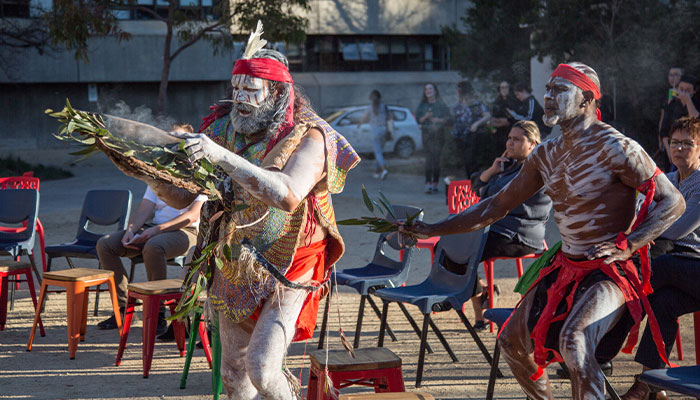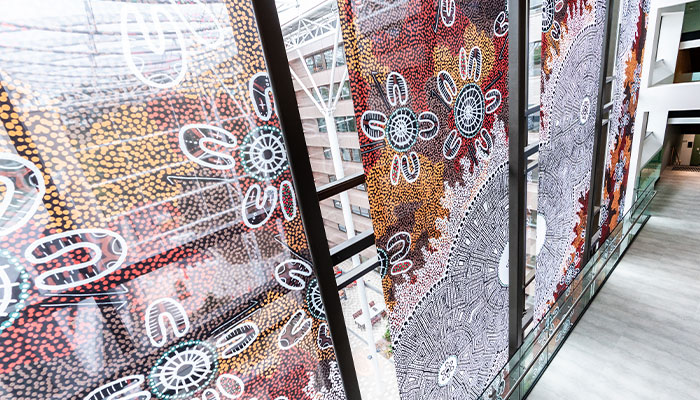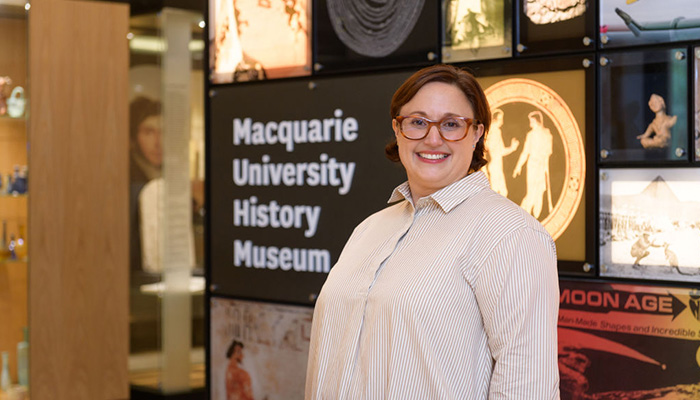In just 20 minutes, Dr Jo Rey can walk down the hill from Macquarie University’s campus library to the place now called Brown’s waterhole, on the Lane Cove (Turrumburra) River, through pathways near known Aboriginal archaeological sites.
This is Wallumattagal-Dharug Country, lands that Dr Rey’s ancestors cared for – along with their resident colonies of Bell Miner birds, parakeets and screeching sulphur-crested cockatoos, lush plant life and all the beings connected to this place.
These places are where Macquarie University Indigenous Studies undergraduates can learn to engage with ‘Ngurra,’ or Country through experiences and cultural connections.
“Wallumattagal means the place of the snapper fish,” explains Dr Rey, an Indigenous Research Fellow in Macquarie’s Faculty of Arts who has a long historical connection with the land from both her Dharug and colonial ancestors.
Adopting Wallumattagal as a campus place name, acknowledges the traditional custodians of the Macquarie University lands.
Brown’s Waterhole, at the junction of Terry’s Creek and Lane Cove River, was named for John Brown, an early timber-getter and the son of Dr Rey’s multi-great grandmother.
“Wallumatta grew me up,” she says. “At Moocooboola, known today as Hunters Hill, I have such strong memories of the Moreton Bay fig trees, where we played as children, the smell of the mangroves in the Turrumburra estuary at the meeting of the fresh water and the salt water, and where we would find the Wallumai – the black snapper fish.”
Today, some of these ancestral lands are the site of Macquarie University’s North Ryde campus, which stretches across 126 hectares of now-open grassland, stands of mature trees including eucalypts, melaleuca and casuarina, and urban wetlands and creeks feeding into the nearby Lane Cove River.
Wallumattagal – recognising Country
In recognition of the Dharug Country on which the University sits, the Macquarie University Namesake Working Group proposes to rename the site ‘Wallumattagal campus at North Ryde,’ as part of the University’s 10-year Indigenous Strategy launched in 2017.

Dharug Country: Indigenous dancers at the opening of the Walangu Maru pavilion launch at Macquarie University ... plans are under way to rename the North Ryde campus to reflect the Country on which it sits.
“Adopting Wallumattagal as a campus place name, acknowledges the traditional custodians of the Macquarie University lands, connecting its ancient history through to the beautiful contemporary campus,” says Dr Leanne Holt, a Worimi/Biripi woman and Pro Vice-Chancellor for Indigenous Strategy, who chairs the Namesake Working Group.
Dr Holt says many names given to geographical and built features around Australia are reminders of colonisation, violence and displacement of Aboriginal and Torres Strait Islander people.
“Re-naming the campus provides us with the opportunity to tell a true history,” Dr Holt said.
Macquarie University Vice-Chancellor, Professor S Bruce Dowton, said the name change is an opportunity to change the narrative.
“Macquarie University acknowledges and honours the Aboriginal and Torres Strait Islander people of Australia as the nation’s first people and recognises that, as the traditional custodians and occupants of the land, they have a spiritual, social, cultural and economic relationship with their traditional lands and waters,” says Professor Dowton.
New Arts Precinct includes ancient culture and artefacts
Artwork by Aboriginal artist and Macquarie University student Dylan Barnes, inspired by the interaction of knowledge and learning with community, hangs in the heart of Macquarie University’s award-winning new Arts Precinct, launched in March.

At the heart: Indigenous art lines the intercultural foyer of the new Arts Precinct.
The launch included the opening of Macquarie University’s History Museum which holds more than 18,000 artefacts ranging from collections of ancient manuscripts on papyrus and ancient glass to items of Australian history.
“The purpose-built Arts Precinct showcases the Faculty’s identity through the display of student and staff achievements, and is a hub for interaction between staff, students, partners and the community,” says Professor Martina Möllering, Executive Dean of the Faculty of Arts.
The new precinct includes three buildings featuring open and flexible working spaces, an expansive roof garden, a digital lab, language centre, an “ideas hub” with video and audio production facilities for students and an Intercultural Foyer featuring a 14-metre digital screen to display student work and research.
“We hope to shape the academic lives of our staff and students by providing a precinct where they can feel inspired, energised and excited to be part of the future of Arts, Humanities and Social Sciences research and learning,” says Mollering.



